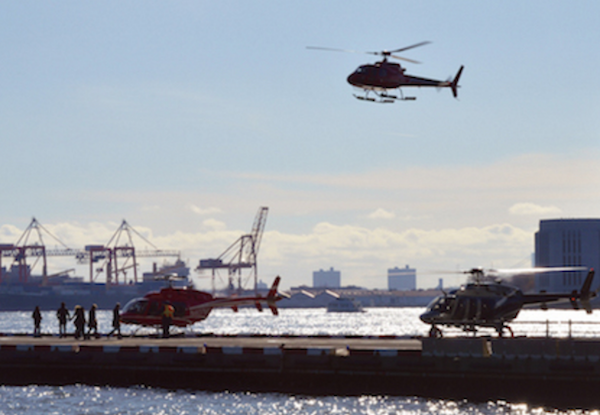
BY COLIN MIXSON | A group of mayoral appointees voted to extend the deal allowing tourist helicopters to operate over Manhattan from Downtown’s Pier 6 — over the opposition of elected officials who hoped to deny any contract that would allow the locally loathed industry to persist.
All of the appointed members of the city’s Franchise and Concession Review Committee voted on July 13 in favor of extending the concession allowing Saker Aviation Services to operate helicopter tours out of the Downtown Manhattan Heliport for another five years, while writing into the contract the terms of an agreement reached earlier this year to cut the number of flights in half by 2017.
But the only elected officials with a vote on the panel — Borough President Gale Brewer and City Comptroller Scott Stringer — voted against the new contract, arguing that the helicopter tour industry should be banished from Manhattan entirely.
“There should be no tourist helicopters in New York City, period,” said Stringer, who preceded Brewer as borough president. “They provide little economic payback and instead bombard our communities with unrelenting noise and pollution, which is why they’ve been banned elsewhere in the five boroughs.”
“Helicopter tours for a handful of people inflict noise and pollution on thousands upon thousands of New Yorkers, with little in the way of economic benefit to show for it,” said Brewer. “We should get rid of helicopter tourism entirely.”
In comments critical of the helicopter tourism last fall, Upper West Side City Councilmember Helen Rosenthal said, “On good weather days there are more than 300 flights a day. Because they run a loop on the Upper West Side, from Downtown Manhattan up to the George Washington Bridge and back, each flight has two points of noise impact — so it’s over 600 quality-of-life violations a day for Upper West Side residents.”
Helicopter-tour operators and the de Blasio administration, however, have consistently argued that the economic benefits to the city — which also bags $2.9 million in annual rent for the heliport — outweigh the misery of residents.
The concession extension, which passed with a 4–2 vote, will allow the high-flying tour guides to operate out of the Downtown Manhattan Heliport until April 30, 2021, while giving the city the option to extend that date by a year, twice.
The committee also voted to ratify agreements reached between Saker and the Economic Development Corporation, which controls the heliport, to reduce the number of tourist flights overall, ban flights on Sundays, cease flights over Governors Island and Staten Island, and monitor air quality around the heliport, along with requiring the operator to research and implement new technologies to mitigate noise pollution and emissions as they become commercially feasible.
But those modifications, which were designed to ease the burden the industry places on residents, are ill-defined and inadequate in providing real benefits for locals, according to Stringer.
“This flawed compromise fails to give the city the enforceable oversight it would need to restore any semblance of peace and quiet for hundreds of thousands of residents,” Stringer said in a statement.
In particular, the agreement fails to institute any real means of holding Saker accountable for air and noise pollution in not specifying what measures the EDC can take when those limits are exceeded, according to Stringer. The agreement also fails to specify to what degree Saker must invest in research to mitigate helicopter noise and emissions and when those measures should be considered economically feasible, Stringer said.
The terms codified in the new concession were agreed to by EDC and Saker in January as a way to preempt legislation introduced by Rosenthal and her Council colleagues Margaret Chin from the Lower East Side and Brooklyn’s Carlos Menchaca that effectively would have banned the helicopter tourism industry in New York City by imposing noise limits that helicopters used in the industry could not meet.
When the terms negotiated by the EDC and Saker were announced early this year, Stop the Chop NYNJ, an advocacy group that opposes the industry, were harshly critical of the three councilmembers, charging they had abandoned the battlefield.
“It’s a complete sell-out by our elected officials, especially Councilmembers Chin, Rosenthal, and Menchaca,” said John Dellaporta, the group’s head. “They promised us they were going to try to enact a complete ban, and instead behind our backs cut a deal with the helicopter industry.”
Rosenthal, however, noting that advocates and elected officials have been working on the helicopter issue for a decade, said of those voicing impatience, “They would like the three of us [councilmembers] to work miracles and pass this bill immediately.”
In reaction to the franchise contract renewal, Rosenthal said, “I’m looking forward to seeing the first report from the helicopter agreement. It won’t sit on a shelf — we’ll scrutinize it to make sure the tourist helicopter industry is holding up their side of the deal.”
Tour flights thunder in and out of the Pier 6 heliport 28 times every hour during the day, six days a week, according to figures from the Helicopter Tourism & Jobs Council, amounting to more than 100,000 take-offs and landings each year.
Despite that, the number of 311 complaints relating to chopper noise is relatively low, with just under 1,300 complaints relating to helicopter noise in 2014, compared to nearly 130,000 complaints related to noisy parties.
But that number provides little comfort to locals who live around the busy helipad or the choppers’ route.
“It’s truly a constant onslaught of noise,” said Craig Abruzzo, Stop the Chop’s vice president.
“I’ve lived on the Upper West Side for almost 40 years — my home is now a bunker in a war zone that offers little refuge from the thunderous roar and shaking vibrations caused by helicopter tours,” said Rhonda Waggoner, an Upper West Side resident who turned out for a Council hearing on the chopper flights last fall. — Additional reporting by Yannic Rack




























